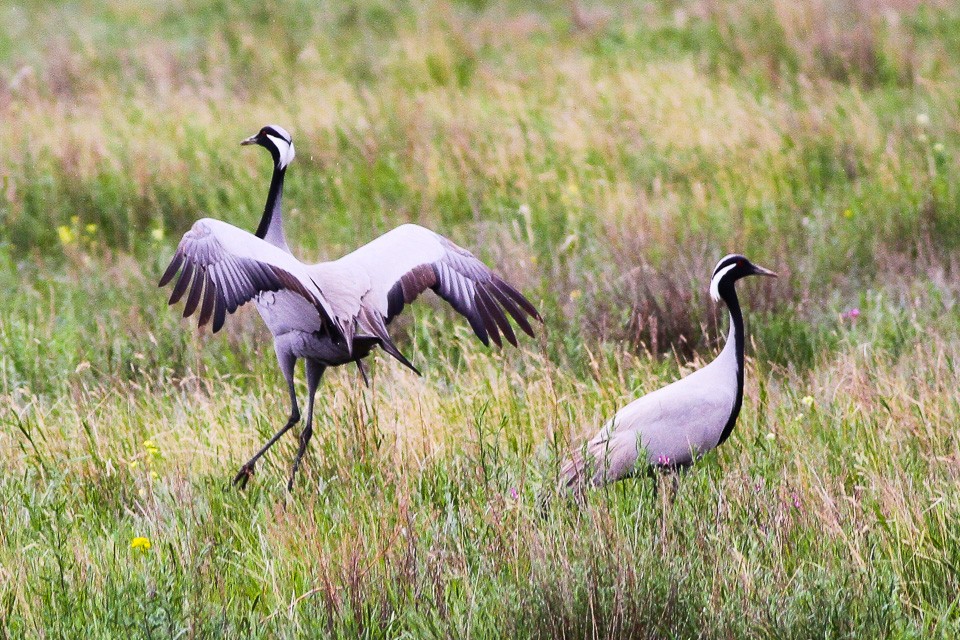Demoiselle Crane
A species of Blue and Demoiselle Cranes Scientific name : Grus virgo Genus : Blue and Demoiselle Cranes
Demoiselle Crane, A species of Blue and Demoiselle Cranes
Botanical name: Grus virgo
Genus: Blue and Demoiselle Cranes
Content
Description People often ask General Info
Description
The demoiselle is 85–100 cm (33.5–39.5 in) long, 76 cm (30 in) tall and has a 155–180 cm (61–71 in) wingspan. It weighs 2–3 kg (4.4–6.6 lb). It is the smallest species of crane. The demoiselle crane is slightly smaller than the common crane but has similar plumage. It has a long white neck stripe and the black on the foreneck extends down over the chest in a plume. It has a loud trumpeting call, higher-pitched than the common crane. Like other cranes it has a dancing display, more balletic than the common crane, with less leaping. The demoiselle was so named by Queen Marie Antoinette, for its delicate and maiden-like appearance. 
Size
90 cm
Nest Placement
Ground
Feeding Habits
Demoiselle Crane primarily eat seeds and plants, with a summer diet including insects like beetles, worms, lizards, and small vertebrates. They forage by walking slowly and often feed in large flocks in cultivated fields during migration, occasionally damaging crops.
Habitat
The demoiselle Crane predominantly occupies savannas, steppes, and various grassland regions, often situated near streams, lakes, and wetlands. The species is found in semi-desert to desert environments with accessible water sources and has adapted to agricultural landscapes. Their wintering habitats include agricultural fields, with a preference for roosting in adjacent wetlands.
Dite type
Omnivorous
People often ask
General Info
Feeding Habits
Bird food type
Behavior
The demoiselle crane lives in a variety of different environments, including desert areas and numerous types of grasslands (flooded, mountain, temperate and tropical grassland) which are often within a few hundred metres of streams or lakes. However, when nesting, they prefer patchy areas of vegetation which is tall enough to conceal them and their nests, yet short enough to allow them look out for predators whilst incubating their eggs. Demoiselle cranes have to take one of the toughest migrations in the world. In late August through September, they gather in flocks of up to 400 individuals and prepare for their flight to their winter range. During their migratory flight south, demoiselles fly like all cranes, with their head and neck straight forward and their feet and legs straight behind, reaching altitudes of 16,000–26,000 feet (4,900–7,900 metres). Along their arduous journey they have to cross the Himalayan mountains to get to their over-wintering grounds in India. Many die from fatigue, hunger and predation from golden eagles. Simpler, lower routes are possible, such as crossing the range via the Khyber Pass. However, their presently preferred route has been hard-wired by countless cycles of migration. At their wintering grounds, demoiselles have been observed flocking with common cranes, their combined totals reaching up to 20,000 individuals. Demoiselles maintain separate social groups within the larger flock. In March and April, they begin their long spring journey back to their northern nesting grounds. In Khichan, Rajasthan in India, villagers feed the cranes on their migration and these large congregations have become an annual spectacle. The demoiselle crane is evaluated as Least Concern on the IUCN Red List of Threatened Species. It is one of the species to which the Agreement on the Conservation of African-Eurasian Migratory Waterbirds (AEWA) applies. 
Species Status
Not globally threatened.
